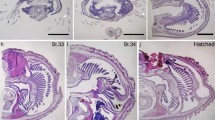Summary
The statocyst of the ctenophore, Pleurobrachia pileus, was studied by light and electron microscopy and by histochemical techniques. The following results, which partly extend the findings of other authors were obtained: the statocyst consists of a bilateral symmetric cushion-like epithelium, which is arched over by a so-called cupula. The cupula is built up by cells which are interwoven by “balancer”-cilia and contains sulphurylated mucoid substances. Underneath the cupula there is the complex of the intracellular statoliths. In the unspecific epithelium of the statocyst there are sulphurylated mucoid substances as well. In addition it contains presumably vibration sensitive cilia with a strongly modified onionshaped root. In the specific and unspecific epithelium of the statocyst the reaction products of the alkaline phosphatase are distributed evenly and in granular form. In the four groups of cells at the borders of the specific epithelium, bearing the double-rooted balancer-cilia, the reaction products of ATPase, acid phosphatase and acetylcholinesterase were detected histochemically. In the remaining superficial cell layer of the specific epithelium acidic substances occur. In addition it shows fine cilia with split rootlets. As already seen by light microscopy four groups of lamellated bodies are found at a medium level of the specific epithelium. They presumably develop from multiple reduplicated centriols and have no connection with the cell membrane. The lamellated bodies are surrounded by cell processes containing numerous secretory granules and microtubules. The basal layer of the specific epithelium is rich in B-esterases and is characterized by two types of cells: dense, cuboidal cells which presumably are stem cells and elongated clear cells, the processes of which are particularly rich in microtubules.
It is discussed wether morphologically distinct receptors are cooperating in the sense of a functional entity and wether there exist typical nervous structures or not. A scheme summarizing the reported results takes into account the recent findings from other laboratories.
Zusammenfassung
Die Statocyste der Ctenophore Pleurobrachia pileus wurde lichtmikroskopisch, histochemisch und elektronenmikroskopisch untersucht. Folgende Ergebnisse, die zum Teil die Feststellungen anderer Autoren ergänzen, wurden erzielt: Die Statocyste besteht aus einem bilateral symmetrischen Zellpolster, das von einer sog. Cupula überwölbt wird. Die Cupula baut sich aus mit „balancer“-Cilien durchflochtenen Zellen auf und enthält schwefelsäureesterhaltige Mukosubstanzen. Unterhalb der Cupula befindet sich die Masse der intrazellulär liegenden Statolithen. In dem unspezifischen Statocystenepithel lassen sich ebenfalls schwefelsäureesterhaltige Mukosubstanzen nachweisen. In ihm kommen ferner mutmaßlich vibrationssensible Cilien mit stark modifizierter, kolbenförmiger Wurzel vor. Die Reaktionsprodukte der alkalischen Phosphatase sind im unspezifischen und spezifischen Statocystenepithel gleichmäßig granulär verteilt. Die vier Zellgruppen am Rand des spezifischen Statocystenepithels, die die zweiwurzeligen „balancer“-Cilien tragen, geben positive Reaktionen auf ATPase, saure Phosphatase und Acetylcholinesterase. Die übrige oberflächliche Zellschicht des spezifischen Statocystenepithels enthält saure Substanzen und trägt feine Cilien mit gespaltener Wurzel. In mittlerer Höhe des spezifischen Statocystenepithels liegen die schon lichtmikroskopisch sichtbaren vier Gruppen der sog. Lamellenkörper, die sich wahrscheinlich aus mehrfach reduplizierten Centriolen entwickeln und keinen Zusammenhang mit der Zellmembran haben. Die Lamellenkörper werden von Zellfortsätzen umgeben, die zahlreiche Sekretgranula und Mikrotobuli enthalten. Die Basis des spezifischen Statocystenepithels ist reich an B-Esterasen und ist durch zwei Zelltypen charakterisiert: dichte, kubische Zellen, die vermutlich Stammzellen darstellen, und langgestreckte, helle Zellen, deren Fortsätze besonders viele Mikrotubuli enthalten. Die Frage nach dem funktionellen Zusammenspiel morphologisch verschiedener Rezeptoren und das Vorkommen eindeutig nervöser Strukturen werden diskutiert. Ein Schema faßt die Befunde zusammen und ergänzt die bekannten schematischen Darstellungen der Statocyste (Hyman, 1940; Barnes, 1963) unter Berücksichtigung der Beobachtungen von Horridge (1963–1969).
Similar content being viewed by others
Literatur
Barnes, R. D.: Invertebrate zoology. Philadelphia-London: W. B. Saunders Comp. 1963.
Brown, P. K., Gibbons, I. R., Wald, G.: The visual cells and visual pigment in the mudpuppy Necturus. J. Cell Biol. 19, 79–106 (1963)
Chun, C.: Ctenophoren des Golfes von Neapel. Engelmann, Leipzig 1880.
Fawcett, D. W.: Die Zelle. München: Urban & Schwarzenberg 1969.
Hertwig, R.: Über den Bau der Ctenophoren. Jena. Z. Med. Naturw. 14, 313–457 (1880).
Horridge, G. A.: Presumed photoreceptive cilia in a ctenophore. Quart. J. micr. Sci. 105, 311–317 (1963).
Horridge, G. A.: Non-motile sensory cilia and neuromuscular junctions in a ctenophore independent effector organ. Proc. roy. Soc. B, 162, 333–350 (1965a).
Horridge, G. A.: Relations between nerves and cilia in ctenophores. Amer. Zool. 5, 357–375 (1965b)
Horridge, G. A.: Pathways ov koordination in ctenophores. In: The cnidaria and their evolution, ed. W. J. Ress. London-New York: Academic Press 1966
Horridge, G. A.: Statocystes of medusae and evolution of stereocilia. Tissue and Cell 1, 341–353 (1969)
Horridge, G. A., Mackay, B.: Neurociliary synapses in Pleurobrachia (Ctenophora). Quart. micr. Sci. 105, 163–174 (1963)
Hündgen, M., Weissenfeldt, N., Schäfer, D.: Der Einfluß der Osmolalität auf die Fixierungsqualitäten von acht verschiedenen Aldehyden. Cytobiol. Bd. 4, Heft 1, 62–72 (1971)
Hyman, L. H.: The invertebrates: Protozoa through ctenophora, vol. I, p. 662. New York: Graw Hill 1940
Jha, R. K., Mackie, G.: The recognition, distribution and ultrastructure of hydrozoan nerve elements. J. Morph. 123, 43–61 (1967).
Samassa, P.: Zur Histologie der Ctenophoren. Arch. mikr. Anat. 40, 157–242 (1892).
Slautterback, D. B.: Cytoplasmatic microtubules. J. Cell Biol. 18, 367–388 (1963)
Sotelo, C., Palay, S. L.: The fine structure of the lateral vestibular nucleus in the rat. J. Cell Biol. 36, 151–179 (1968)
Author information
Authors and Affiliations
Rights and permissions
About this article
Cite this article
Krisch, B. Über das Apikalorgan (Statocyste) der Ctenophore Pleurobrachia pileus . Z.Zellforsch 142, 241–262 (1973). https://doi.org/10.1007/BF00307035
Received:
Issue Date:
DOI: https://doi.org/10.1007/BF00307035




